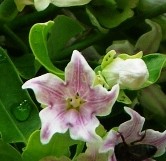 Also known as moth plant and white bladderflower, this fast growing creeping vine is a native of Argentina and Brazil where it grows in forest margins, river banks and disturbed sites. It is considered a weed in Australia and New Zealand. The gray to gray-green twining stems exude a milky sap when broken and carry leathery dark green leaves with an elongated triangular shape. The pale pink to creamy white bell-shaped flowers are fragrant and produced in clusters of few to many in the axils of the upper leaves. They bloom over a long period from summer into autumn and are pollinated by moths, trapping them by the tongue until late morning when they release the moths unharmed. The pear-shaped fruits are three to four inches long and bluish- or grayish- green when young. They turn brown and woody as they mature and open to release black seeds with a tuft of long silky strands.
Also known as moth plant and white bladderflower, this fast growing creeping vine is a native of Argentina and Brazil where it grows in forest margins, river banks and disturbed sites. It is considered a weed in Australia and New Zealand. The gray to gray-green twining stems exude a milky sap when broken and carry leathery dark green leaves with an elongated triangular shape. The pale pink to creamy white bell-shaped flowers are fragrant and produced in clusters of few to many in the axils of the upper leaves. They bloom over a long period from summer into autumn and are pollinated by moths, trapping them by the tongue until late morning when they release the moths unharmed. The pear-shaped fruits are three to four inches long and bluish- or grayish- green when young. They turn brown and woody as they mature and open to release black seeds with a tuft of long silky strands.
Type: Climbing vine
Outstanding Feature: Fragrant flowers; attractive fruits
Form: Climbing, sprawling
Growth Rate: Rapid
Bloom: Pale pink to creamy white bell-shaped flowers are fragrant and produced in clusters of few to many in the axils of the upper leaves over a long period from summer into autumn.
Size: 20-23’ long
Light: Full sun
Soil: Humusy, moist, well-drained; not limy
Hardiness: Zones 10-11
Care: Remove dead wood and old pods annually
Pests and Diseases: None of significance
Propagation: Seed in early spring.
